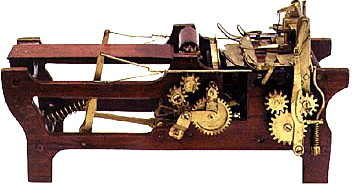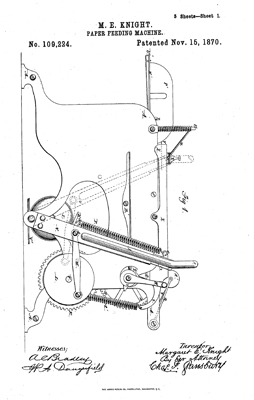 Margaret Knight is credited with over 90 different inventions and she received 26 patents in her lifetime. Her patents included textile and shoe-making machinery, domestic devices, and an automobile engine. She received her first patent at the age of 30 but was inventing her entire life.
Margaret Knight is credited with over 90 different inventions and she received 26 patents in her lifetime. Her patents included textile and shoe-making machinery, domestic devices, and an automobile engine. She received her first patent at the age of 30 but was inventing her entire life.
Ms. Knight’s first invention was at the age of 12, two years after her father passed away. Her brothers began working in a textile mill to support the family, by the time she was 12, she had joined them. When working, Ms. Knight witnessed an accident where a snagged thread caused a spindle to fly off of a machine and injure some of her fellow workers. This experience led to her inventing a stop-motion device that could stop machinery used in textile mills and prevent injury.
Her most notable invention was for a machine used to make paper bags. While working at the Columbia Paper Bag Company in Springfield, Massachusetts, as Ms. Knight had an idea for a new kind of paper bag. Her new bag had a flat bottom the same as paper bags do today. Until then, paper bags were similar to envelopes and unable to hold much. Ms. Knight studied the machines in the paper bag manufacturing plant while working during the day. At night, she made drawings and models of her new machine.
 Patent Number 109,224 was awarded to Margaret on November 15, 1870 for an improvement in paper bag machines. Ms. Knight was forced to defend her patent because Charles Annan spied on her models and was granted a patent for the exact same machine. Annan’s position was that a woman could not possibly have invented such a machine. She defended her position with drawings, models and notes. The courts saw that it was indeed as Ms. Knight who invented the new paper bag machine and she won the law suit.
Patent Number 109,224 was awarded to Margaret on November 15, 1870 for an improvement in paper bag machines. Ms. Knight was forced to defend her patent because Charles Annan spied on her models and was granted a patent for the exact same machine. Annan’s position was that a woman could not possibly have invented such a machine. She defended her position with drawings, models and notes. The courts saw that it was indeed as Ms. Knight who invented the new paper bag machine and she won the law suit.
Working with a Massachusetts businessman, Ms. Knight established the Eastern Paper Bag Co. and received payment for her idea. The new paper bag design quickly became very popular. The flat-bottom bags became the choice for carrying and transporting goods. Large department stores realized that they could utilize the flat-bottom bags to accommodate customer needs without having to take time to wrap a parcel with paper and twine.
Today more than 7,000 machines produce between 200 and 650 bags per minute. They are used for everything from groceries, to school lunches, to pet food.

One thought on “Famous Women Inventors: Margaret Knight – Inventing Since the Age of 12”